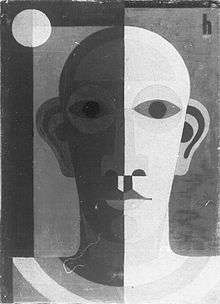Heinrich Hoerle


Heinrich Hoerle (1 September 1895 – 7 July 1936) was a German constructivist artist of the New Objectivity movement.
Hoerle was born in Cologne. He studied at the Cologne School of Arts and Crafts but was mostly self-taught as an artist. After military service in World War I he met Franz Wilhelm Seiwert in 1919 and worked with him on the journal Ventilator.[1] Together with his wife Angelika (1899–1923), Hoerle became active in the Cologne Dada scene. He co-founded the artists' group Stupid, and in 1920 he published the Krüppelmappe (Cripples Portfolio).[1] Hoerle's work retained a certain dour absurdism after he adopted a figurative constructivist style influenced by the Russians Vladimir Tatlin and El Lissitzky and by the Dutch movement De Stijl.[2] His paintings feature generic-looking figures, presented in strict profile or in stiff, frontal poses.
In 1929 he began collaboration with Seiwert and Walter Stern on the publication of publication of "a-z", the journal of the Cologne Progressives art group.[3] He was among the many German artists whose works were condemned as degenerate art when the Nazis took power in 1933.[4] He died in Cologne in 1936.
Public collections holding works by Heinrich Hoerle include Museum Ludwig, Cologne; Kölnisches Stadtmuseum; Stadtmuseum Düsseldorf; The Von der Heydt Museum in Wuppertal; and the Busch-Reisinger Museum in Cambridge, Massachusetts.
Notes
References
| Wikimedia Commons has media related to Heinrich Hoerle. |
- Backes, Dirk; Wolfram Hagspiel and Wulf Herzogenrath (1981). Heinrich Hoerle, Leben und Werk 1895–1936. Cologne. (Ausstellungskatalog Kölnischer Kunstverein)
- Michalski, Sergiusz (1994). New Objectivity. Cologne: Benedikt Taschen. ISBN 3-8228-9650-0
- Poore, Carol (2007). Disability in twentieth-century German culture. University of Michigan Press. ISBN 0-472-11595-2
- Schmied, Wieland (1978). Neue Sachlichkeit and German Realism of the Twenties. London: Arts Council of Great Britain. ISBN 0-7287-0184-7